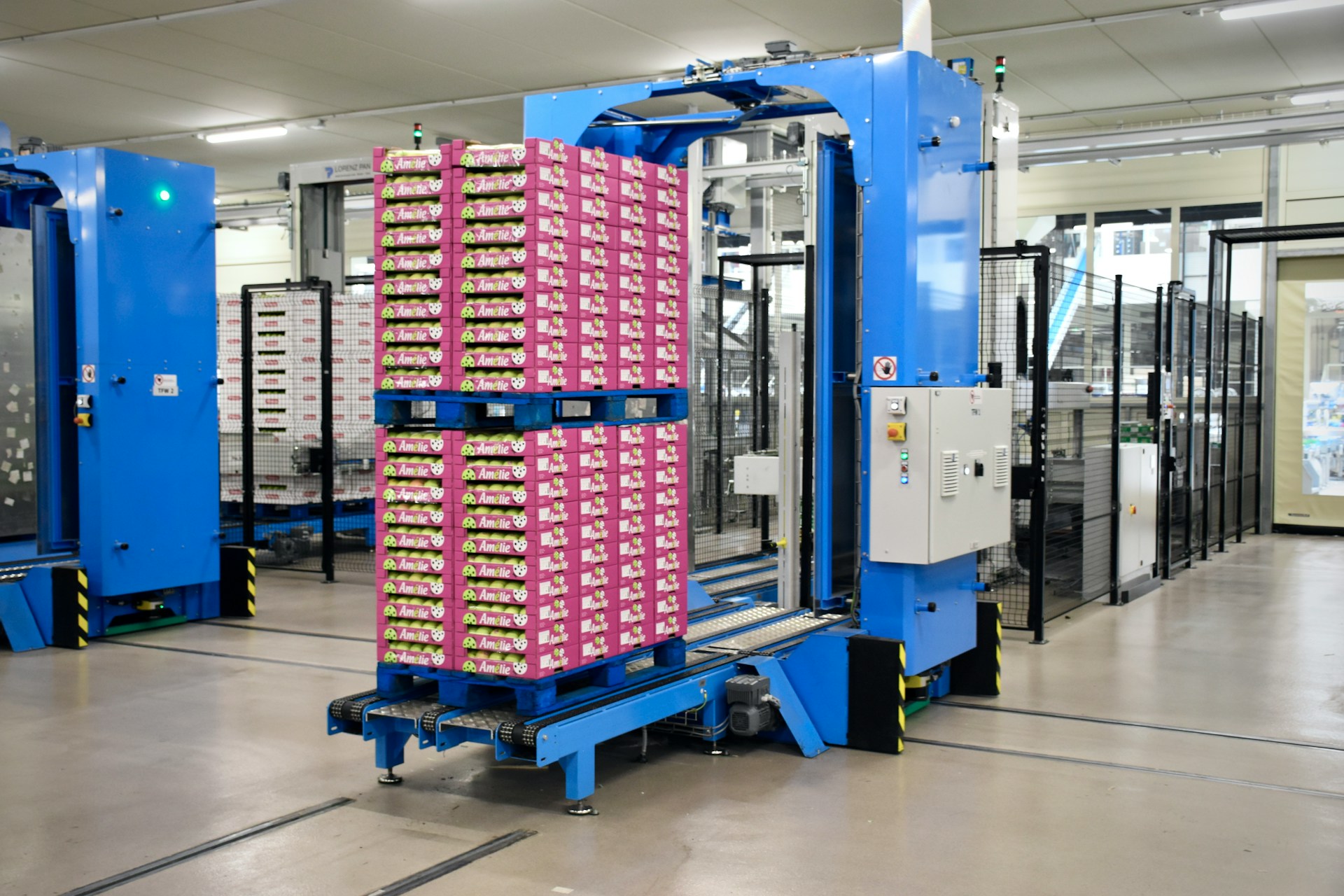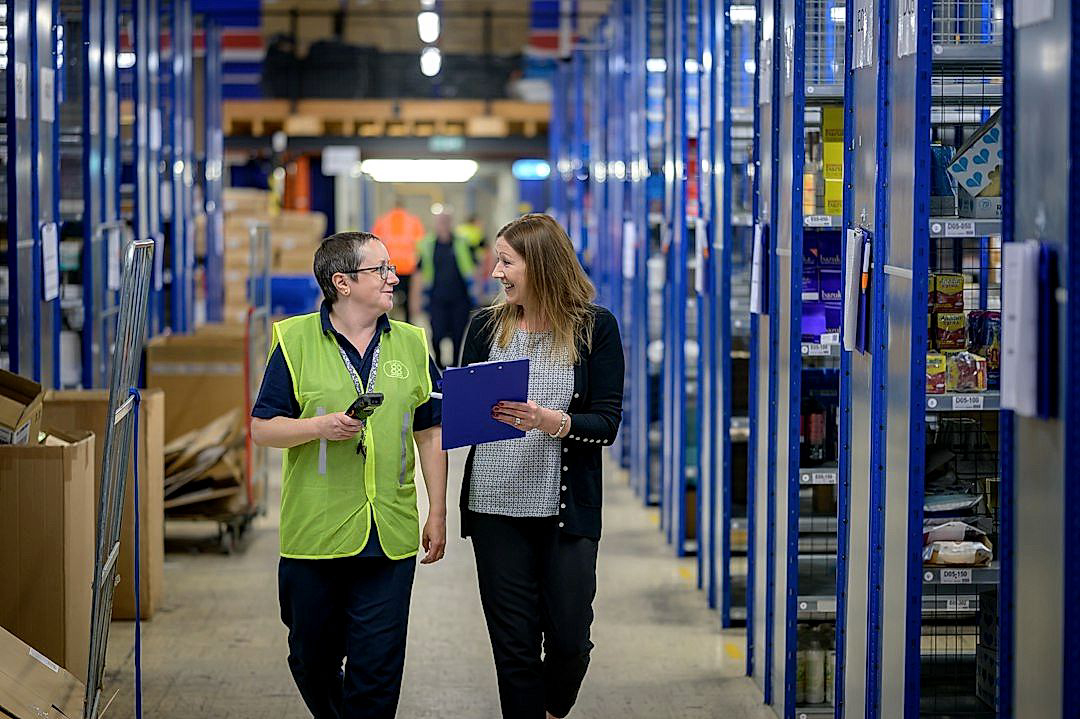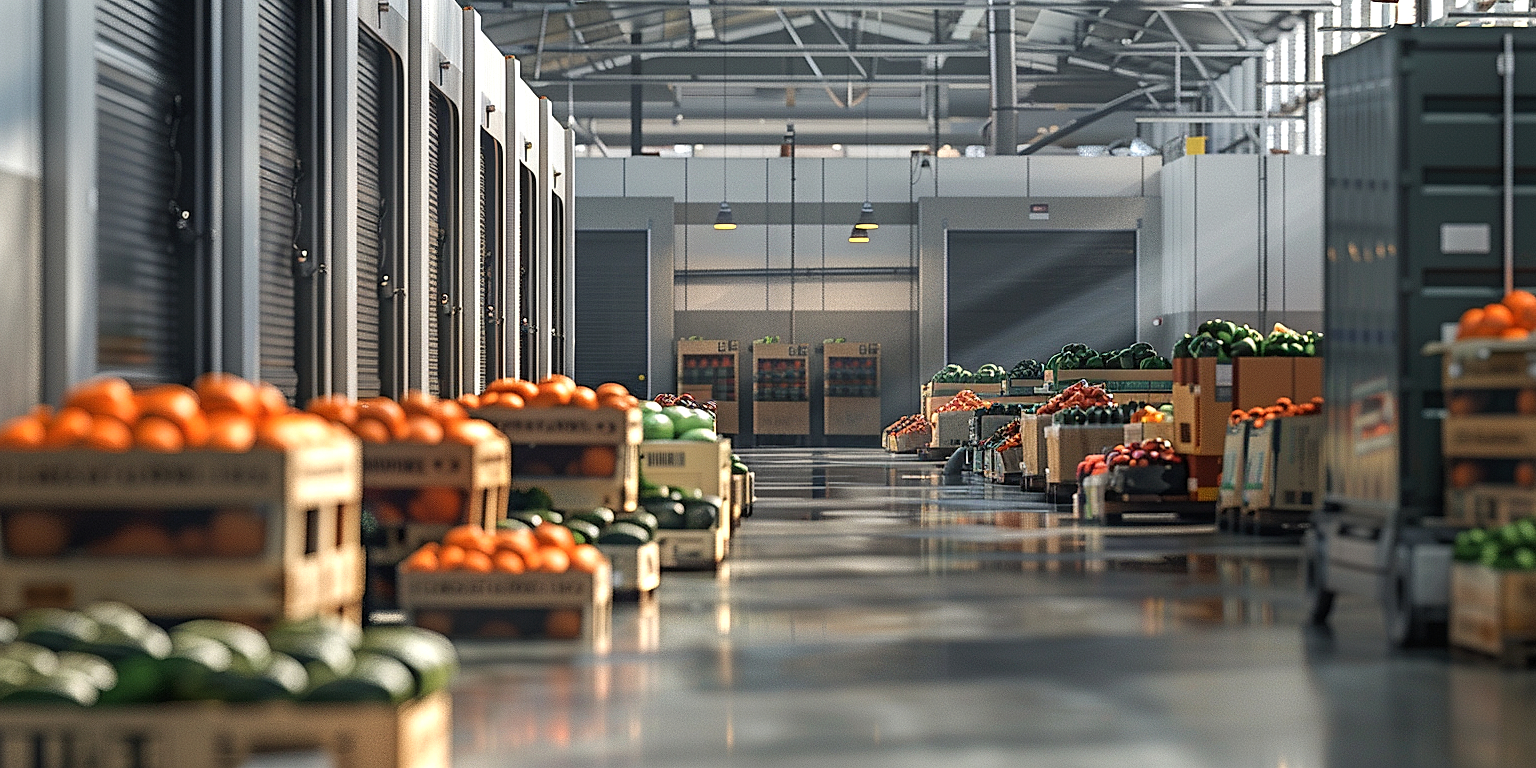Ensuring efficiency and sustainability in the produce distribution industry requires continuous improvement and innovation.
Warehousing forms a vital cog in the machinery of this sector.
This implies that improvements in warehousing technology can lead to substantial improvements in the entire distribution process.
From inventory management to delivery, various aspects can benefit significantly from these upgrades.
This blog will delve into several technological enhancements that can streamline the operations of produce distribution warehouses.
Regardless of the size of the operation, these novel advancements can drive cost reduction and boost overall performance.
Tech Upgrades For Produce Distribution Warehousing
1. Automated Inventory Management Systems
The application of technology in the produce distribution industry has transformed nearly every aspect of its operation, one of which includes the paramount task of inventory management.
Automated inventory management systems, as an integral part of such tech upgrades, bring unprecedented efficiency to traditional warehousing processes.
This revolutionary tool maximizes precision and speed in tracking inventory, especially for fresh produce that necessitates prompt handling and distribution.
The system operates by using barcodes or radio-frequency identification (RFID) tags on each produce pallet or box, enabling it to swiftly and accurately monitor the movement of each product in real-time.
The data it provides is beneficial as it can be used to pinpoint where a specific product is within the warehouse, and also track its journey from the point of arrival until its departure.
Saving the time staff would otherwise spend manually logging and identifying products, the automated inventory management system allows them to focus on more important tasks while significantly reducing the chances of any errors which could lead to loss of fresh produce and subsequently, revenue.
Furthermore, this tech upgrade aids in providing data-driven insights for business optimizations.
With an accurate count of inventory and real-time visibility, companies can prevent overstocking or understocking situations, allowing them to maintain an optimum inventory level which not only saves space and resources, but also helps maintain the freshness of the produce.
The system also can be programmed to send automated alerts when inventory levels hit a predefined threshold, further supporting effective inventory management.
Additionally, the comprehensive and chronological data log of each product facilitates a more organized system for first-in, first-out (FIFO) operations, an essential practice in produce distribution to maintain freshness.
By incorporating such technologies, companies can take a proactive approach to pattern recognition, providing valuable inputs for forecasting future demand and planning acquisition schedules more efficiently.
This also decreases the likelihood of waste, as perishable produce is less likely to spoil if it’s not left sitting in inventory unbeknownst to management, which again is enabled by the vigilant eyes and high tech capabilities of an automated inventory management system.
Moreover, considering the global emphasis on sustainability, automated inventory systems can be a boon in promoting responsible business practices by curtailing waste and embracing efficient resource utilization.
To sum up, technology upgrades such as automated inventory management systems offered substantially improve efficiency, accuracy, and sustainability in the produce distribution industry, making it an excellent investment for those looking to optimize their operations while maintaining freshness and reducing waste.
2. Advanced Refrigeration Technology
The implementation of advanced refrigeration technology is a pivotal upgrade in produce distribution warehousing.
By harnessing cutting-edge technologies, companies can greatly enhance the performance of their refrigeration systems, ultimately improving the preservation of perishable goods.
This technology offers highly efficient cooling processes, which significantly reduces energy consumption and decreases operational costs.
Furthermore, sophisticated refrigeration systems employ digital controls and automation to maintain optimal storage conditions, thus limiting the risk of spoilage and waste.
Deploying advanced refrigeration technology can drastically extend the shelf-life of perishable products, promoting a more sustainable distribution process.
The use of smart sensors in these advanced systems enables real-time monitoring and swift response to temperature discrepancies, ensuring the products’ integrity.
In the case of any irregularities or malfunctions with the refrigeration system, instant alerts are triggered, mitigating potential losses.
The introduction of such technology is also a practical response to the increasingly stringent standards and regulations governing food safety and quality in many regions.
Beyond the warehouse, advancements in refrigeration technology also play a vital role in the transportation of perishable products.
Modern refrigeration units for transportation are designed to maintain steady temperatures, regardless of external climate conditions, ensuring the fresh arrival of products to their final destination.
Incorporating cutting-edge refrigeration technology into the warehouse equips businesses with the tools needed to preserve the quality and freshness of their produce from farm to table.
Thus, upgrades in refrigeration technology serve not only to improve warehousing operations but also to enhance the entire supply chain, offering a competitive edge in the market.
Investing in advanced refrigeration technology is a strategic move that can significantly increase efficiency, minimise waste, and ensure product quality, leading to improved profitability in the long run.
Above all, the adoption of these technologies demonstrates a business’s commitment to sustainability and superiority in handling and preserving fresh produce.
3. IoT Enabled Tracking Systems
As the world of Produce Distribution Warehousing evolves, the integration of IoT enabled tracking systems is increasingly becoming a necessity.
Modern warehouses incorporate IoT technologies to boost efficiency, improve coordination and reduce human error.
IoT enabled tracking systems facilitate real-time visibility into the whereabouts of each unit within the warehouse, hence fostering timely and accurate decision making.
The systems use sensory technology to identify and locate items, providing immediate data about their exact location in the warehouse.
This results in improved warehouse layout efficiency and maximizes utilization of storage space, consequently driving cost savings.
Additionally, tracking systems can monitor environmental conditions in the warehouse such as temperature and humidity, critical for preserving the freshness of the produce.
These systems can flag any irregularities and alert warehouse staff in real time, preventing potential losses due to spoilage.
Another advantage of IoT enabled tracking systems is their ability to monitor and predict equipment performance, reducing the probability of downtime and increasing overall warehouse efficiency.
The system can send alerts for predictive maintenance based on device performance metrics.
This preventive measure ensures that equipment functions optimally and reduce the chances of costly repairs.
The power of IoT is not only limited to tracking items or monitoring equipment, it extends to the arena of security.
IoT devices such as CCTV cameras and remote access control systems can provide comprehensive surveillance in and around warehouse premises.
Furthermore, IoT technology also favors scalability.
As warehouses grow and processes become more complex, tracking systems enabled by IoT can be upgraded or expanded effortlessly, ensuring businesses stay up-to-date with the latest tech solutions.
Thus, employing IoT tracking systems in produce distribution warehousing can effectively transform the traditional operations into a smarter and more efficient model.
The implementation of IoT in warehouse management is a testament to how modern technologies can be leveraged to create superior, cost-efficient, and dynamic solutions in the commercial world.
4. AI Powered Demand Forecasting Tools
Distribution warehouses in the produce industry are increasingly adopting advanced technologies such as Artificial Intelligence (AI) powered demand forecasting tools.
The primary objective of these technological tools is to boost the accuracy of demand prediction, eliminate waste and optimize inventory management.
AI algorithms utilize historical data, current trends and market intelligence to predict future stock requirements.
By leveraging big data and sophisticated algorithms, these systems offer greater prediction accuracy compared to traditional forecasting methods.
Using AI powered demand forecasting tools, warehouses can reduce excess inventory, improving the efficient utilization of storage space.
Moreover, in terms of perishable items such as produce, these tools greatly reduce waste by accurately predicting demand, ensuring the right quantities are stocked.
The success of these tools relies heavily on the quality and granularity of data.
Therefore, it’s essential for companies to invest in proper data collection and processing systems for maximized benefits.
The use of these tools requires sufficient training for warehouse personnel for effective implementation and seamless integration with existing systems.
Furthermore, AI algorithms are continuously learning and updating, which means the accuracy of demand forecasts improves over time.
These AI tools are flexible and adaptable to variable market conditions and trends, making them highly efficient for inventory management in the dynamic world of produce distribution.
Security matters are vital when dealing with AI, hence companies must bolster their IT security frameworks to prevent data breaches.
While AI implementation can be costly upfront, its long-term benefits in enhancing supply chain efficiency undeniably outweigh the initial investment.
Some challenges that may arise include resistance to change from staff or the complexity of integrating these AI tools with existing IT infrastructure.
Undoubtedly, the utilization of AI-powered demand forecasting tools is a major technological upgrade that will significantly improve produce distribution warehousing.
5. Robotic picking and packaging systems
The introduction of robotic picking and packaging systems is arguably one of the most transformative tech upgrades for produce distribution warehousing.
This shift towards automated systems not only enhances precision but also significantly escalates the pace of operations.
Unlike human pickers, robots do not tire or require breaks, thus ensuring uninterrupted warehouse functions round the clock.
These high-capacity systems can pick a wide array of products, irrespective of their shapes and sizes.
By leveraging advanced machine learning algorithms, robotic picking systems can identify and remember the picking patterns of various products for improved efficiency over time.
This feature becomes immensely valuable when dealing with a wide assortment of produce.
Moreover, the integration of sensors in these robotic systems minimizes the risk of damage to delicate produce during the picking process.
The automation of the picking process removes any human error, resulting in significantly reduced waste and losses.
The robotic packaging systems in conjunction improve warehouse operations just as much.
These systems are able to package items faster than human workers, resulting in shorter order fulfillment cycles.
Comparison of different packaging formats can be done swiftly by these robots and selection of the ones most suitable for the type of produce to be packed can be done without much fuss.
With the ability to adjust based on the packing demand, these systems offer greater flexibility in managing warehouse operations during peak and off-peak periods.
Errors during the packaging process are significantly reduced, contributing to improved customer satisfaction rates.
With the integration of robotic picking and packaging systems, warehouses can achieve greater accuracy and efficiency in their operations.
Progressive advancements in technology will undoubtedly continue to boost the capabilities of robotic systems in the future, offering greater potential benefits for produce distribution warehousing.
The investment made now to implement the robotic picking and packaging systems will bring enormous exponential benefits in the near future.
6. Real-time Data Analytics Software
The advent of real-time data analytics software is a game changer in the landscape of produce distribution warehousing.
The role of this advanced tech tool can’t be overstated as it provides businesses with immediate information that aids in timely decision-making to keep operations running smoothly.
Real-time data analytics software enables warehouse managers to track and interpret various activities transpiring within the warehouse.
It forms a fundamental part of inventory management, ensuring that all processes are transparent and timely.
Real-time data analytics software provides visual dashboards that show produce inflow and outflow, enabling warehouse managers to extrapolate inventory forecasts accurately and efficiently manage supply and demand.
Through data analytics, user-behavior tracking becomes easier, providing insights on how warehouse activities can be optimized for better productivity.
This software can also work to detect any irregularities or discrepancies in operations, ensuring that any issues are addressed swiftly and effectively.
By using real-time data analytics, warehouse activities can be monitored in real time, ensuring that any possible deviation from established parameters can be promptly dealt with.
Moreover, the software aids in the ferreting out of unused assets within the warehouse, thus helping in maximizing space utilization and increasing operational efficiency.
Warehouse managers can rely on this software to accurately measure parameters such as travel times, picking times, and idle times, which are critical in developing productivity benchmarks.
Apart from enhancing operational efficiency, using real-time data analytics software can significantly reduce costs.
Businesses can cut back on expenses associated with overstocking and stock shortages because the software ensures accurate inventory management.
Alerts can be customized to be sent whenever there’s a chance of inventory falling below adequate levels, helping to keep a tight control over the inventory.
Besides inventory management, this software also plays an instrumental role in averting losses due to spoilage of perishable goods.
Its data can be used to optimize storage and distribution, ensuring that produce is preserved adequately and reaches consumers in the best condition.
All in all, the multitude of benefits provided by real-time data analytics software make it an essential tool in modern produce distribution warehousing.
7. Energy-efficient warehouse lighting solutions
With the rapid progress in technology, several viable energy-efficient lighting solutions have been developed for warehousing environments.
The introduction of these technologies has been catalyzed by the growing need to minimize energy consumption and consequently reduce operational costs.
Energy-efficient lighting systems, such as LED lights, for instance, consume considerably less power than traditional warehouse lighting solutions.
Not only do they help in cutting down electricity costs, but they also enhance the overall visibility within the warehouse, which is fundamental for operational efficiency.
The role of energy-efficient warehouse lighting solutions is not just limited to the reduction of energy bills, it also aids in providing a safer, more efficient working environment.
Moreover, the implementation of smart lighting solutions can significantly improve inventory handling processes.
Such systems use sensors to adjust lighting levels based on activity and occupancy, optimizing energy usage throughout the warehouse.
These systems work by dimming or turning off lights in unoccupied areas{” “} and brightening areas where workers are present, thereby creating a dynamic lighting environment.
In addition to these, some advanced lighting solutions also come with integrated IoT technology that provides real-time data on energy usage.
This data can be utilized to further optimize the lighting system and achieve greater energy savings.
Furthermore, many energy-efficient lighting technologies have longer lifespans compared to traditional lighting solutions, leading to reduced maintenance costs and downtime.
This longevity also contributes to the sustainability efforts of the business, as the need for frequent replacements is minimized, thereby reducing waste.
Another pivotal point is that making the switch to energy-efficient warehouse lighting might also render businesses eligible for energy efficiency incentives and rebates, provided by some local governments and organizations.
It’s clear that these energy-efficient warehouse lighting systems offer numerous benefits over traditional lighting solutions, making them a crucial technological upgrade in the realm of produce distribution warehousing.
Hence, businesses operating in this domain should consider investing in such lighting solutions that prove to be beneficial from an operational, financial, and sustainability perspective.
The Bottom Line
Advancements in automation and digital technology are progressively reshaping the logistics and supply chain industry.
Automated inventory management systems, advanced refrigeration technology, IoT enabled tracking systems, and AI-powered demand forecasting tools are streamlining operations and enhancing productivity.
Upgrades to robotic picking and packaging systems and the adoption of real-time data analytics software have set new standards in efficiency, precision and accuracy.
Beyond the operational aspect, the move towards energy-efficient warehouse lighting solutions showcases a commitment to sustainability.
Leveraging these technologies, the industry is well-equipped to face future challenges, optimize resources, reduce costs, and achieve sustainable growth, thereby revolutionizing the way we understand and manage supply chains.




